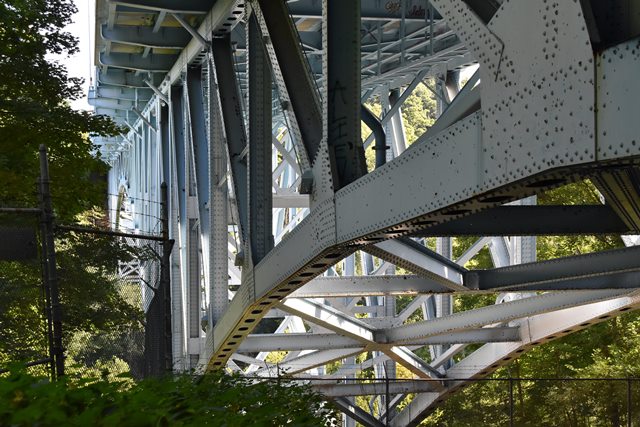We Recommend:
Bach Steel - Experts at historic truss bridge restoration.
BridgeHunter.com Phase 1 is released to the public! - Visit Now
Main Street Bridge
High Level Bridge

Primary Photographer(s): Nathan Holth
Bridge Documented: August 24, 2019
Akron and Cuyahoga Falls: Summit County, Ohio: United States
1948 By Builder/Contractor: Bates and Rogers of Chicago, Illinois and Bethlehem Steel Company of Bethlehem, Pennsylvania and Engineer/Design: Wilbur J. Watson and Associates of Cleveland, Ohio
1993
480.0 Feet (146.3 Meters)
909.0 Feet (277.1 Meters)
51.8 Feet (15.79 Meters)
3 Main Span(s)
7730306

View Information About HSR Ratings
Bridge Documentation
Although buried by thick forest and difficult to view, this is a large and impressive example of a cantilevered deck truss bridge.
View Archived National Bridge Inventory Report - Has Additional Details and Evaluation
View Historical Article About This Bridge
View Historic Bridge Inventory Sheet For This Bridge
Information and Findings From Ohio's Historic Bridge InventorySummary of Significance The 1948 continuous-cantilever design deck truss bridge is a later example of its type/design that is eligible from the prior inventory. No significant changes in the aspects of integrity were reported. The cantilever truss type/design developed in the U.S. during the 1880s and had emerged by the early 20th century as one of the dominant types for longer spans crossing deep or long rivers where it was difficult, if not impossible, to erect falsework. Truss designs used with cantilever trusses, e.g., Pratt or Warren, mirrored those of the period in which the bridge was built, as did the use of pinned or riveted connections. The great advantage of the cantilever is that it can be built outwards from the towers without falsework to block the channel. Suspended spans can be lifted into place between the cantilever arms. Span lengths of up to 500' are not uncommon, and in the longest examples can exceed 1,000'. The Ohio inventory includes 12 cantilever truss highway bridges dating from 1922 to 1960 (Phase 1A, 2008). Justification The bridge is one of 11 remaining examples of the design used for long, major crossings of both deck and thru trusses. They date from 1922 through the interstate era. This is not the most significant example. The bridge has moderate significance. Bridge Considered Historic By Survey: Yes |
![]()
Photo Galleries and Videos: Main Street Bridge
Bridge Photo-Documentation
Original / Full Size PhotosA collection of overview and detail photos. This gallery offers photos in the highest available resolution and file size in a touch-friendly popup viewer.
Alternatively, Browse Without Using Viewer
![]()
Bridge Photo-Documentation
Mobile Optimized PhotosA collection of overview and detail photos. This gallery features data-friendly, fast-loading photos in a touch-friendly popup viewer.
Alternatively, Browse Without Using Viewer
![]()
Maps and Links: Main Street Bridge
Coordinates (Latitude, Longitude):
Search For Additional Bridge Listings:
Bridgehunter.com: View listed bridges within 0.5 miles (0.8 kilometers) of this bridge.
Bridgehunter.com: View listed bridges within 10 miles (16 kilometers) of this bridge.
Additional Maps:
Google Streetview (If Available)
GeoHack (Additional Links and Coordinates)
Apple Maps (Via DuckDuckGo Search)
Apple Maps (Apple devices only)
Android: Open Location In Your Map or GPS App
Flickr Gallery (Find Nearby Photos)
Wikimedia Commons (Find Nearby Photos)
Directions Via Sygic For Android
Directions Via Sygic For iOS and Android Dolphin Browser
USGS National Map (United States Only)
Historical USGS Topo Maps (United States Only)
Historic Aerials (United States Only)
CalTopo Maps (United States Only)

